A) It develops when the expected price level exceeds the actual price level.
B) In the long run,this gap will close when resource suppliers negotiate lower resource payments.
C) It measures the amount by which actual output falls short of the economy's potential.
D) In the long run,this gap will close when the short-run aggregate supply curve shifts rightward.
E) In the long run,this gap will close when resource suppliers negotiate higher resource payments.
Correct Answer

verified
Correct Answer
verified
Multiple Choice
The figure below shows the determination of the equilibrium price level and real GDP in an aggregate demand-aggregate supply model.The movement shown in this figure is most likely to be caused by:
Figure 10.6
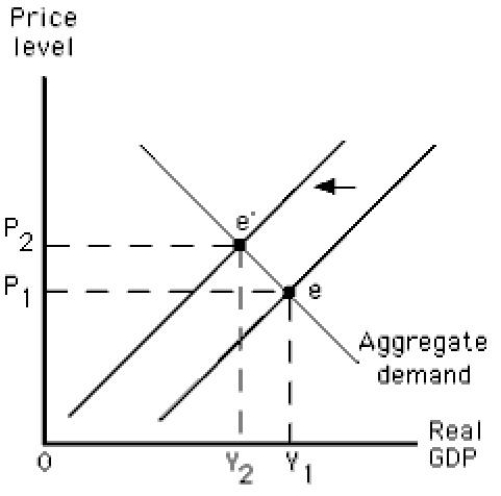
A) a decrease in the real wage.
B) an increase in the economy's capital stock.
C) the actions of a labor union.
D) a decrease in consumer spending.
E) an increase in labor productivity.
Correct Answer

verified
Correct Answer
verified
Multiple Choice
The figure below shows short-run equilibrium in an aggregate demand-aggregate supply model.If the economy is currently producing Y1 level of output,long-run equilibrium will be established if:
Figure 10.5
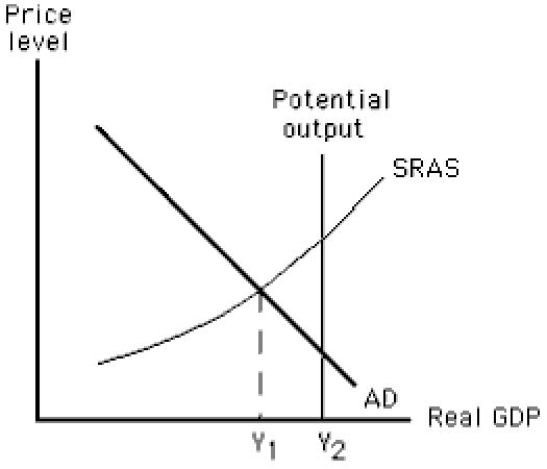
A) the short-run aggregate supply curve shifts to the right to remove the expansionary gap.
B) the short-run aggregate supply curve shifts to the left to remove the expansionary gap.
C) the short-run aggregate supply curve shifts to the left to remove the recessionary gap.
D) the short-run aggregate supply curve shifts to the right to remove the recessionary gap.
E) there is a leftward shift of the aggregate demand curve.
Correct Answer

verified
Correct Answer
verified
True/False
In the long run,the price level is determined by aggregate supply.
Correct Answer

verified
False
Correct Answer
verified
True/False
Workers usually negotiate compensation in terms of the nominal wage because wage agreements are based on expected price levels.
Correct Answer

verified
Correct Answer
verified
Multiple Choice
The rate at which aggregate supply changes to restore equilibrium at potential output depends crucially on:
A) how quickly planned investment spending adjusts to changes in population growth.
B) how quickly planned consumption spending adjusts to changes in the price level and nominal wages.
C) how quickly technology changes to increase aggregate supply.
D) whether the economy is experiencing a recessionary gap or an expansionary gap.
E) how quickly real wages adjust to restore full employment in the labor market.
Correct Answer

verified
Correct Answer
verified
True/False
The natural rate of unemployment includes frictional,cyclical,and structural unemployment.
Correct Answer

verified
Correct Answer
verified
True/False
If the price level increases by 5 percent and the nominal wage increases by 3.5 percent,the real wage will decrease by 1.5 percent.
Correct Answer

verified
Correct Answer
verified
Multiple Choice
Which of these is most likely to shift the long-run aggregate supply curve to the left?
A) An increase in the average workweek
B) An improvement in technology
C) A civil war
D) A decrease in aggregate demand
E) A decline in global oil prices
Correct Answer

verified
Correct Answer
verified
Multiple Choice
Which of the following explains the shape of the short-run aggregate supply curve?
A) The inverse relationship between the quantity supplied and the cost per unit
B) The direct relationship between the quantity supplied and the cost per unit
C) The direct relationship between the quantity supplied and the price level
D) The inverse relationship between quantity supplied and GDP
E) The inverse relationship between quantity supplied and the profit per unit
Correct Answer

verified
Correct Answer
verified
Multiple Choice
The figure below shows short-run equilibrium in an aggregate demand-aggregate supply model.In this figure,the distance between points Y1 and Y2 represents:
Figure 10.5

A) an expansionary gap.
B) a recessionary gap.
C) the potential output.
D) seasonal unemployment.
E) structural unemployment.
Correct Answer

verified
Correct Answer
verified
Multiple Choice
Suppose the actual and expected price levels in an economy are initially equal.However,the actual price level falls eventually due to a change in economic conditions.Which of the following will occur over the long run?
A) The economy will move rightward along the short-run aggregate supply curve.
B) The economy will move leftward along the short-run aggregate supply curve.
C) The short-run aggregate supply curve will shift to the right.
D) The short-run aggregate supply curve will shift to the left.
E) The short-run aggregate supply curve will become flatter.
Correct Answer

verified
Correct Answer
verified
Multiple Choice
In constructing a short-run aggregate supply curve,we assume that the goal of business is to:
A) maximize sales revenue.
B) maximize profit.
C) maximize growth in assets.
D) maximize growth in sales.
E) minimize cost.
Correct Answer

verified
Correct Answer
verified
Multiple Choice
If the price level in the current year is much higher than the expected price level,_____.
A) firms will increase production beyond the economy's potential level
B) the unemployment rate will increase
C) firms will decrease production below the economy's potential level
D) the short-run aggregate supply curve will become steeper
E) the unemployment rate will fall to zero
Correct Answer

verified
Correct Answer
verified
Multiple Choice
The figure below shows the short-run aggregate supply of an economy.Which of the following is likely to be true if the actual price level in this figure exceeds the expected price level?
Figure 10.1
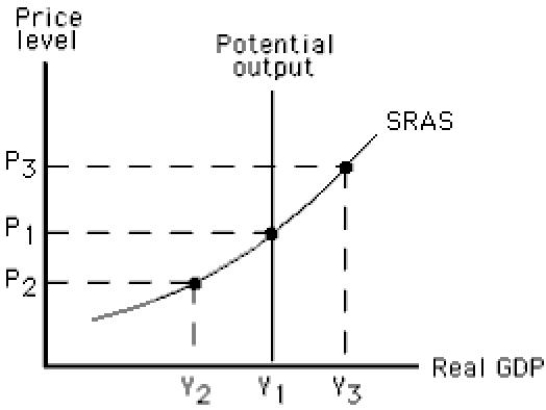
A) Equilibrium output will be Y2 in the short run.
B) Equilibrium output will be Y1 in the short run.
C) The actual unemployment rate is below the natural rate.
D) Potential output is greater than actual output.
E) The actual price level is less than the equilibrium price level.
Correct Answer

verified
Correct Answer
verified
Multiple Choice
The figure given below depicts long run equilibrium in an aggregate demand-aggregate supply model.Which of the following is indicated by the arrow given in this figure?
Figure 10.8
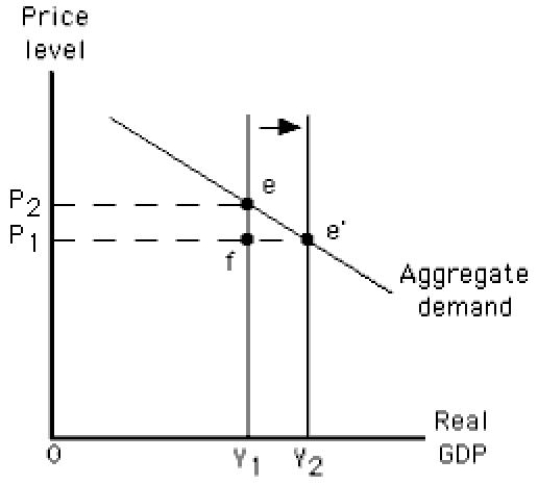
A) A decrease in capital stock
B) An increase in long-run aggregate supply
C) An increase in nominal wage
D) A decrease in long-run aggregate supply
E) A decrease in the aggregate quantity demanded
Correct Answer

verified
B
Correct Answer
verified
Multiple Choice
Which of the following is true in the short run?
A) The aggregate supply curve is horizontal.
B) The aggregate supply curve is vertical.
C) Per-unit costs do not increase as much as output prices when the price level rises.
D) An increase in price per unit results in a decrease in profit per unit.
E) Firms' total costs of production decrease as output expands beyond the potential level.
Correct Answer

verified
Correct Answer
verified
Multiple Choice
The more the short-run output exceeds an economy's potential,_____.
A) the smaller the expansionary gap
B) the greater the upward pressure on the price level
C) the larger the recessionary gap
D) the greater the downward pressure on the price level
E) the lesser the demand for resources
Correct Answer

verified
Correct Answer
verified
Multiple Choice
The figure below shows equilibrium in an aggregate demand-aggregate supply model.Which of the following will be true of an economy in the long run that is at point M in the short run?
Figure 10.4
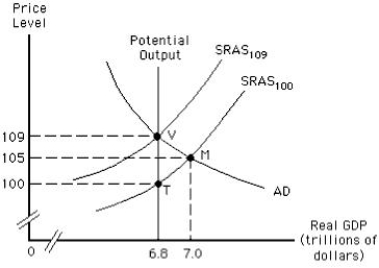
A) The actual price level will be lower than the expected price level.
B) The actual output will fall short of the potential output.
C) The short-run aggregate supply curve will remain stable at SRAS100.
D) The short-run aggregate supply curve will shift to SRAS109.
E) Real GDP will be equal to nominal GDP.
Correct Answer

verified
Correct Answer
verified
Multiple Choice
In the short run,there is a positive relationship between:
A) inflation and unemployment.
B) inflation and real GDP.
C) the actual price level and the aggregate quantity supplied.
D) the actual price level and unemployment.
E) the actual price level and consumption spending.
Correct Answer

verified
C
Correct Answer
verified
Showing 1 - 20 of 150
Related Exams